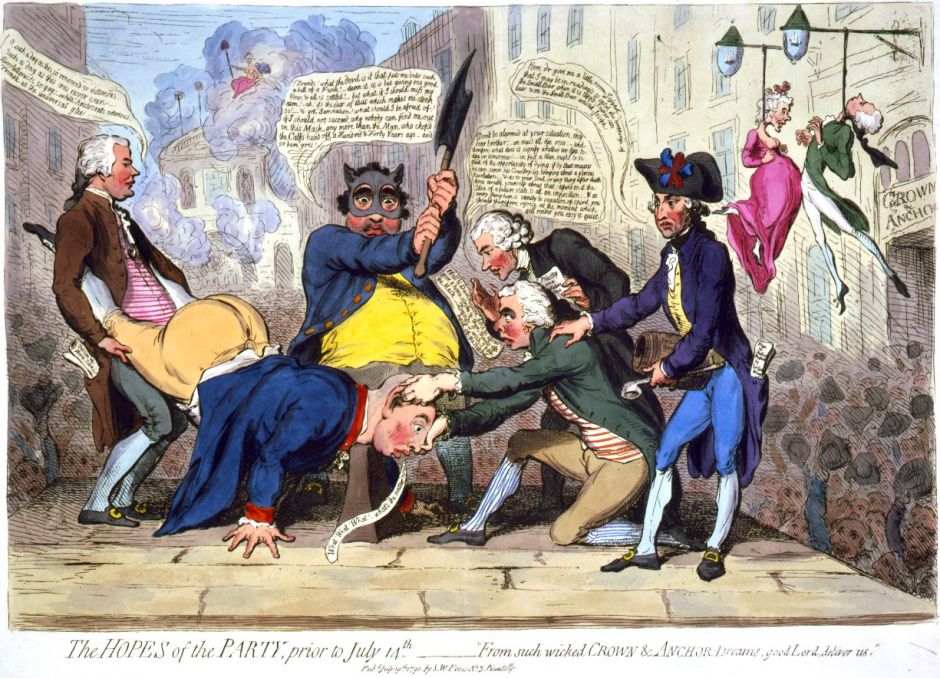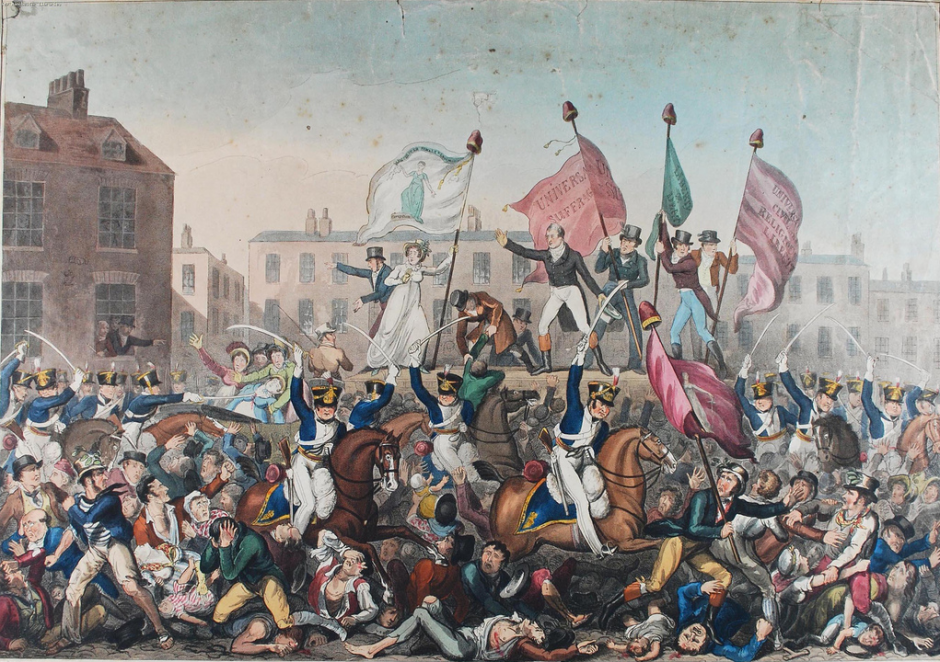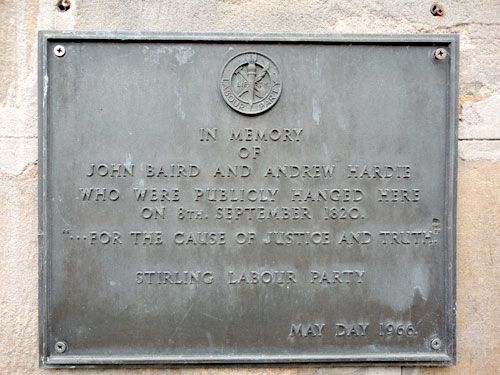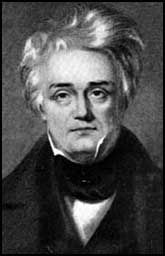A Very Political Regiment: Radicalism and the Rifle Corps
By Kieran Hazzard
At first glance political Radicalism, is not the first idea one might attribute to the men of the 95th, men who had fought for their king against republican France. However, early 19th century politics was an unsettled environment and a surprising number of former Riflemen became involved with political protest in the years following the wars.
A Short History of Radicalism
During the period of the Revolutionary and Napoleonic Wars and into the mid-nineteenth century, political Radicals in Britain stood for the destruction of the traditional social order through revolutionary or political means. The movement was a disparate one, with many individual groups sprouting up across the country, all calling for varying programmes of reform, but all aimed at redistributing power away from the traditional elites and into the hands of the people.
The system of Rotten Boroughs and an elective franchise based upon large property holdings effectively barred anyone but the wealthiest from electing MPs; apart from in a few boroughs such as Westminster where the more open franchise allowed Radicals to elect their leaders to Parliament. At general elections this limited franchise, in constituencies which did not reflect the shifts in population and left the growing manufacturing towns unrepresented, allowed for a great deal of corruption. In many Rotten Boroughs small bodies of electors were bribed or coerced by local magnates to elect men of their choosing.
Drawing inspiration from the Levellers, the American Revolution, British history and the Revolution in France, British Radicalism argued against the limited nature of the Georgian political nation and the widespread use of patronage and corruption to maintain aristocratic power, and for the re-distribution of constituencies. Different strands of the movement developed, with middle class 'Reformers' aiming to widen the franchise to represent commercial and industrial interests and towns without parliamentary representation, while 'Popular Radicals' drawn from the working class and from artisans agitated to assert wider rights including relieving distress. What united the movement, however, was the rallying call of ‘Universal Suffrage’.
In the wake of the French Revolution, Radical organisations sprang up across the country, demanding economic relief, universal male suffrage and annual elections. Several groups would go further, expressing their support for the redistribution of property or women’s rights. The numbers involved in these movements were small, and most wanted reform rather than revolution, but for the first time the people were organising for political change. The government reacted harshly, imprisoning leading Radicals, temporarily suspending habeas corpus in England and passing the Seditious Meetings Act 1795 which meant that a license was needed for any meeting in a public place consisting of fifty or more people. Throughout the Napoleonic Wars the government took extensive stern measures against feared domestic unrest and was largely successful in crushing dissent.

In the industrialising North, bands of men called the Luddites began to organise to protest workers rights. Many had been textile artisans who had lost their jobs to the introduction of machinery, which in the worsening economic conditions of the war meant poverty and starvation. The movement began in Nottingham in 1811 and spread rapidly over the following two years. Luddites burned cotton mills and machinery, and for a short time the Luddites were strong enough to clashed openly with the army. At one time, there were more British soldiers fighting the Luddites than Napoleon on the Peninsula. The government sought to suppress the Luddites with a mass show trial at York in January 1813. Over sixty men were charged with various crimes in connection with Luddite activities, all of which were found guilty as a collective. Many were sentenced to death or transportation quickly ending the movement.
After Waterloo the government introduced the Corn laws, which imposed high duties on imported grain, raising the price of bread. The idea had been to encourage domestic production, however, it was largely viewed as the landowners passing a law in their own interest at the expense of ordinary people. Combined with bad harvests, a small electoral franchise and widespread unemployment during the post war depression, this could only foster widespread discontent, leading to rioting in both 1816 and 1817.
This course of events culminated in the infamous Peterloo Massacre of 1819. When the Manchester Patriotic Union, a group agitating for parliamentary reform, organised a demonstration to be addressed by the well-known radical orator Henry Hunt, a crowd of around 60,000 attended. This was viewed with great suspicion by the authorities and shortly after the meeting began, local magistrates called on the military authorities to arrest Hunt and several others on the hustings with him, and to disperse the crowd. Cavalry charged into the crowd with sabres drawn, and in the ensuing confusion, 15 people were killed and around 700 injured.

Over the next decade or so the political force of Radicalism would ebb once more as the government cracked down and the economy picked up. By the 1830s, however, the clamour for reform and once more reached a crescendo, with popular pressure causing the fall of Wellington’s government and the Whigs coming to power in order to pass the Great Reform Act. This was in fact both a triumph and a defeat for Radicals; for whilst it ended the Rotten Boroughs and gave the vote to many members of the wealthy middle class, it stripped the movement of their crucial support. Over the course of the century workers would continue to organise and pressure for change, and Radicalism would go through many transformations and gain further concessions from government, however, it would take until 1918 for all their demands, including universal suffrage, to be achieved.
Riflemen Come to the Fore
In the run up to Peterloo in August 1819 there were numerous gatherings of Radicals, some of which saw the men prepare for armed resistance, should the government use the army against its own people. With so many recently discharged soldiers, desperate and unable to find work, there was no shortage of willing and experienced recruits to these 'patriotic bands'. One such gathering was at Tandle Hill, Oldham, where in the early hours of the morning of 8th August around 2000 men mustered to practice drill manoeuvres. Below is a contemporary account of the scene that morning,
'The front rank was said to be composed entirely of men who have been in the army, the pivot men of non-commissioned officers. There was a separate rifle company of about 85 young men who continued to practice the rifle movements, and what is remarkable there was a discharged rifle men in uniform upon each of the pivots.'
It is quite possible one of the Riflemen observed drilling on Tandle Hill, was Thomas Haigh, who would later become embroiled in a disturbance with other soldiers because of his Radical views. The incident took place in the Swan Public House on the 20th July 1820, where three privates from the 5th Dragoon Guards sat drinking. An ex-soldier stood up and said ‘Here’s a health to the King and Queen’, at which Haigh called out, ‘Here’s to hell with the King and Queen’ and then struck the other fellow. A fight broke out in which the inebriated Haigh was ejected from the room, still spoiling for a fight. For this affray Haigh lost his army pension and was sentenced to three months in prison. (Further, insights into the situation in Oldham can be found our very own Iain Wilkinson's History of Oldham Volunteer Corps, 1798-1908).
In Scotland, agitation culminated in an attempted general strike and an abortive workers' uprising which was crushed by government troops in what became known as the 'Radical War' of 1820. One of the three ‘Radical Martyrs’ executed for their part in the Scottish insurrection was Rifleman John Baird.
Baird had joined the 2nd battalion of the 95th on 13 September 1806 in Glasgow. Promoted to bugler, he went with his battalion in the expeditionary force commanded by General Whitelock to attack Napoleon's Spanish allies in Buenos Aires. Returning with the 95th to Spain he saw action during the Peninsular campaign under Wellington. By 1812 he was stationed at Getafe outside Madrid. On 15 March 1813 Baird returned to Glasgow on furlough. He was due to report back to his unit on 22 May but obtained a certificate from the district surgeon, Glasgow, stating that he was ill. On 22 June 1813 he was posted as a deserter. There is no record that the army was able to arrest him. Like many others at this period he simply disappeared.
Baird eventually returned to his family in Condorrat and joined his father and brothers in the weaving trade. He could read and write very well, began to devour radical literature, and joined his local circulating library, becoming a radical reformer seeking the universal franchise, annual parliaments, and the repeal of the Act of Union with England of 1707. He became a prominent figure among the Condorrat Radicals.
Many Scottish radical leaders saw armed insurrection as the only way to achieve their ends. Conditions were right as the post-war depression and unemployment created great unrest in the industrial south of Scotland, particularly among weavers. Government agents, however, were at work among the Radical leadership. John King of Anderston, sometimes calling himself John Andrews, appeared to be their chief agent. The Glasgow police commander, James Mitchell, reported to home secretary Lord Sidmouth in March 1820 that the radicals were preparing a general rising in Scotland. A few days later, on King's advice, Mitchell arrested the entire 28-man radical central committee in Gallowgate. He then wrote to Lord Sidmouth suggesting that the agents provocateurs take over and issue a call to the rank and file for the rising on, significantly, April Fool's Day. The ‘Proclamation of the provisional government’ was duly issued and some armed Radicals answered the call, to be immediately arrested by the military.
On the evening of 4 April at about 11 p.m. King, the agent, had arrived at the house of John Baird's brother, Robert, and his wife, where Baird was lodging. Baird had been elected commander of the Condorrat insurgents. King told him that he had ‘orders from the central committee’. Baird was to take his men and join with a larger contingent in an attack on the Carron Iron Works near Falkirk, which was the largest single ironworks in Europe, employing 2000 men and supplying all the main artillery pieces to both navy and army. There was, in fact, no larger contingent on the way, and a company of the 80th regiment were at the works waiting for the hapless Radicals.
At 5 a.m. Baird was joined by Andrew Hardie with twenty-five men who had marched up from Glasgow on King's instructions. Baird and his ten men combined forces with them under his command. They set off towards the Glasgow and Edinburgh Canal. King was never seen again after this. Baird split his forces in case he missed the supposed main force, and he and Hardie took separate routes to a point about a mile and a half beyond Bonnybridge village. Here they rejoined forces.
A troop of the 10th hussars and the Stirlingshire Yeomanry were converging on their position. Baird's men were resting on a hill in the area known as Bonnymuir. Hodgson and the 10th hussars led a sabre charge against them. Baird instructed his men to take defensive positions. Hardie wrote:
'Mr Baird defended himself in a most gallant manner; after discharging his piece he presented it at the officer empty, and told him he would do for him if he did not stand off. The officer presented his pistol at him, but it flashed and did not go off. Mr Baird then took the butt end of his piece and struck a private on the left thigh, where upon the sergeant of Hussars fired at him. Baird then threw his musket from him and seized a pike, and while the sergeant was in the act of drawing his sword, wounded him in the right arm.'
But with the reinforcement of yeomanry troops under Davidson, Hodgson called on the insurgents to surrender, and Baird, seeing the futility of a prolonged struggle, agreed. Several of the insurgents were sabred by yeomanry troops after their surrender. Significantly enough, Hodgson already knew the name of the insurgent's leader. King had done his work well.
The wounded were placed on a cart and the prisoners marched to Stirling Castle, where Baird told the commander, Major W. Preddie: ‘Sir, if there is to be any severity exercised towards us, let it be on me. I am their leader, and have caused them being here. I hope that I alone may suffer’. Preddie observed: ‘Throughout he [Baird] never shrunk from the position he assumed’.
The unrest was over within a week and numerous other Radicals were arrested elsewhere in Scotland. There were to be eighty-eight charged with high treason. The trials started in July. The trial of Baird and Hardie, with the Bonnymuir prisoners, began on 13 July at Stirling, with Francis Jeffrey, editor of the Liberal mouthpiece the Edinburgh Review, leading for the defence.
Baird was convicted on two of the four counts of high treason charged against him. On 4 August Baird, Hardie, and twenty others were sentenced to death. The twenty others had their sentences commuted, and a total of twenty-two were transported to the penal colonies for life. Throughout Scotland the other trials resulted in only one other death sentence. This was on 63-year-old James Wilson, a weaver of Strathaven.

On Friday 8 September 1820 Baird and Hardie were led to a public execution platform at Stirling Castle in front of a crowd of several thousand. Before his execution Baird told the crowd: ‘What I have hitherto done, and which brought me here, was for the cause of truth and justice’. The sympathy of the crowd caused the officer commanding to order his troops to present arms and a panic ensued. Sheriff Ranald MacDonald of Staffa refused to let the speeches continue. Both Baird and Hardie were hanged, their bodies cut down after half an hour, and their heads severed and held up with the cry: ‘Behold the head of a traitor!’
When details of how the insurrection had been initiated by government spies and agents provocateurs were revealed by Peter Mackenzie in his An Exposure of the Spy System Pursued in Glasgow (1832) a protest movement forced the Whig government of 1835 to ask William IV to grant absolute pardons to all the 1820 insurgents who had been transported for life. It was not until 1847 that the bodies of Baird and Hardie were exhumed from Stirling Castle and placed in Sighthill cemetery, Glasgow. Wilson was commemorated in his native Strathaven.
A Different Perspective
Thus ended one Rifleman's bid for freedom. To illustrate the very different experiences of Riflemen who became involved in the Radical cause is the story of another former soldier in the years after the defeat of Napoleon.
Thomas Perronet Thompson was the son of a gentleman, commissioned as second lieutenant in 1806 with the Rifles, rising to the rank of major by 1825. He was captured by the Spaniards after General Whitelock's ill-fated expedition against Buenos Aires in July 1807. In 1813–14 he saw action against the French at Nivelles, Nive, Orthez, and Toulouse.
In 1808, after returning from captivity in South America, Thompson became the first crown-appointed governor of Sierra Leone. When he discovered undisguised slavery in Sierra Leone, however, and realized the government had been misled about the colony's social and economic conditions, Thompson introduced an extensive range of reforms and made serious allegations against the colony's former administrators. Embarrassed by his revelations, the government recalled him in 1810. Thompson was convinced that he had been sacrificed in order to save face and was deprived of the opportunity to publicly vindicate his policies in Africa.

After the war he became a close friend of John Bowring, editor of the Radical organ the Westminster Review, who introduced Thompson to Jeremy Bentham and his circle of Philosophical Radicals. Developing an ever keen interest in political economy, Thompson published his Catechism on the Corn Laws (1827) calling for repeal, which proved extremely influential, and went into eighteen editions by 1834; prompting Thompson's election to the Royal Society in 1828. The death of his father in 1828 brought him a modest fortune, and he began to devote himself to Radical causes. The financial difficulties of the Westminster Review prompted him to become its part owner and co-editor from 1829 until he sold up to Sir William Molesworth in 1836. He was a prolific contributor to the Review, and his articles on parliamentary reform, Catholic emancipation, and free trade were particularly influential.
Gaining a seat in Parliament, Thompson was a consistent supporter of Radical reform and free trade, but his political alliances could and did change because he placed principle above party. He was not reluctant to vote against usual allies when he thought they were in the wrong. Thompson knew and co-operated to varying degrees with most of the leading radicals of his era. His most active period outside parliament came in the late 1830s and early 1840s, when he was a tireless spokesman and fund-raiser for the Anti-Corn Law League, a promoter of ‘sensible’ Chartism, and the advocate of broad liberal alliances in towns where co-operative effort drawing in Whigs, moderate reformers, and radicals seemed to be most viable. Thompson continued to campaign on the issues he believed in for the rest of his life.
Baird and Thompson are two prominent examples, from opposite ends of the class system, of Riflemen becoming heavily involved in Radical politics in the post-Napoleonic world. Yet as the soldiers at Oldham show they were certainly not alone. This added to further numbers from across the light infantry suggests a correlation. It could be tentatively proposed that the training received at Shorncliffe, the importance placed on individual awareness and decision making in combat and the unusual familiarity between the officers and their men within the Rifle Corps, all contributed to soldiers more inclined to independent thought and officers more aware of the ordinary man's plight; both significant factors in leading towards Radicalism.
